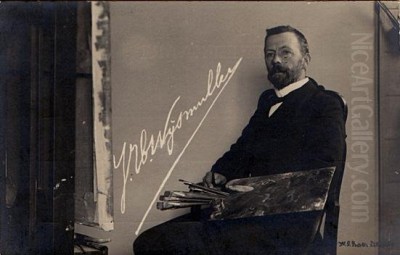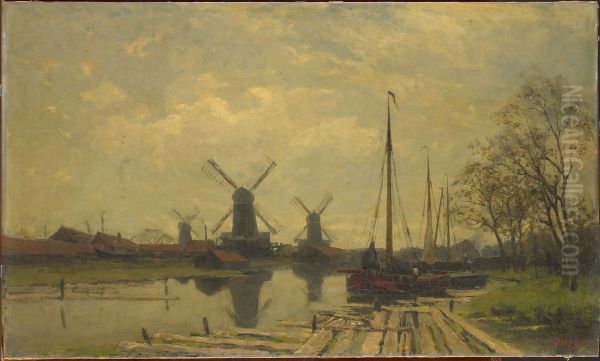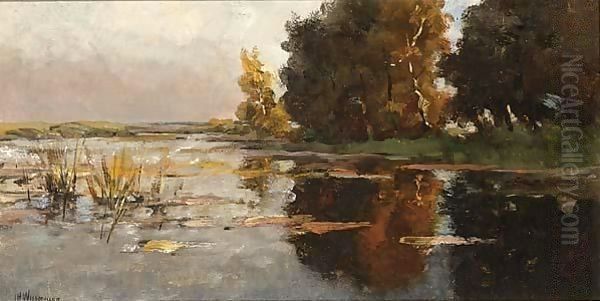
Jan Hillebrand Wijsmuller stands as a significant figure in Dutch art history, particularly associated with the later phase of the renowned Hague School movement. Born in Amsterdam in 1855 and passing away in 1925, Wijsmuller dedicated his artistic career to capturing the landscapes, cityscapes, and coastal views of the Netherlands. He developed a distinctive style characterized by bright palettes and clear compositions, distinguishing himself especially through his mastery of watercolor. His works serve as both beautiful depictions of his homeland and important documents of Dutch art at the turn of the 20th century.
Early Life and Artistic Formation
Jan Hillebrand Wijsmuller's journey into the world of art began in his birthplace, the vibrant city of Amsterdam. Born on February 13, 1855, he showed an early inclination towards the visual arts. His formal training commenced at the prestigious Rijksacademie van Beeldende Kunsten (Royal Academy of Fine Arts) in Amsterdam. This institution was a crucible for artistic talent in the Netherlands, providing rigorous training grounded in academic traditions but increasingly open to newer currents.
During his time at the Rijksacademie, Wijsmuller likely studied under influential figures such as August Allebé, a painter and educator known for his emphasis on careful observation and technical skill. The Academy provided a solid foundation in drawing, painting, and composition, equipping young artists like Wijsmuller with the necessary tools to develop their individual voices. Amsterdam itself, with its picturesque canals, historic architecture, and bustling life, offered ample subject matter for an aspiring artist.
Seeking to broaden his horizons and deepen his artistic understanding, Wijsmuller continued his studies in The Hague. This city was the heart of the eponymous Hague School, a movement that had revolutionized Dutch landscape painting by emphasizing realism, atmosphere, and the unique quality of Dutch light. Immersing himself in this environment allowed Wijsmuller to absorb the principles and techniques of leading Hague School artists, shaping his future direction.

Further enriching his artistic perspective, Wijsmuller also spent time studying in Brussels. The Belgian capital had its own vibrant art scene, influenced by both French Realism and the burgeoning Impressionist movement. This exposure to different artistic currents outside the Netherlands likely contributed to the development of Wijsmuller's brighter palette and perhaps a looser approach compared to some of the earlier, more tonal Hague School masters. This period of diverse training laid the groundwork for his mature style.
The Context of the Hague School
To fully appreciate Jan Hillebrand Wijsmuller's contribution, it is essential to understand the Hague School movement within which he operated. Emerging around the 1860s and flourishing through the late 19th century, the Hague School marked a significant departure from the romanticized landscapes that had previously dominated Dutch art. Inspired partly by the French Barbizon School painters like Jean-Baptiste-Camille Corot and Charles-François Daubigny, Dutch artists sought a more direct, realistic, and atmospheric depiction of their own environment.
The first generation of Hague School artists, including figures like Willem Roelofs, Jozef Israëls, Jacob Maris, Anton Mauve, and Hendrik Willem Mesdag, focused on capturing the mood and light of the Dutch landscape. They often worked outdoors (en plein air) to observe nature directly. Their palettes were frequently characterized by muted tones, emphasizing shades of grey, brown, and silver to convey the often overcast skies and damp atmosphere of the Netherlands. Subjects ranged from tranquil polder landscapes and canals to dramatic seascapes and intimate scenes of peasant and fishing life.
These artists aimed to portray the simple, unadorned beauty of their surroundings. Jozef Israëls became known for his poignant depictions of fisherfolk, while Jacob Maris excelled at capturing the expansive, cloudy skies above Dutch towns and waterways. Willem Maris focused on pastoral scenes, often featuring cattle near water under luminous skies, and Anton Mauve, Vincent van Gogh's cousin-in-law, painted sensitive landscapes with sheep or figures. Hendrik Willem Mesdag became the preeminent painter of the North Sea coast, particularly Scheveningen.
By the time Wijsmuller became active, the Hague School was entering its later phase, sometimes referred to as a "second generation" or simply the Late Hague School. While still rooted in the principles of realism and atmospheric observation, artists of this period often employed brighter colors and sometimes a slightly looser brushstroke, reflecting the growing influence of French Impressionism. Figures associated with this later period, alongside Wijsmuller, might include Willem de Zwart and Floris Arntzenius, though stylistic boundaries could be fluid.

This later phase saw a continuation of landscape and cityscape themes, but often with a greater emphasis on light effects and color vibrancy. Wijsmuller's work fits comfortably within this evolution, retaining the Hague School's commitment to Dutch subjects while embracing a more luminous and colorful approach than many of his predecessors. He, along with his contemporaries, carried the legacy of the Hague School into the early 20th century.
Wijsmuller's Distinctive Style and Technique
Jan Hillebrand Wijsmuller carved out his own niche within the Late Hague School through a distinctive combination of subject matter, color sense, and technical skill. While clearly indebted to the Hague School's focus on atmospheric realism, his work often possesses a clarity and brightness that sets it apart. He moved away from the predominantly grey and brown palettes of some earlier masters, infusing his canvases and papers with more vibrant blues, greens, and yellows, capturing the effects of sunlight on the Dutch landscape.
His compositions are typically well-structured and clear, offering accessible views of canals, windmills, villages, and city streets. There is a certain directness and legibility in his work, avoiding excessive sentimentality while still conveying a deep appreciation for the scenes depicted. He had a particular talent for rendering the interplay of light and water, a recurring motif in his oeuvre, capturing reflections and the transparency of canals with notable skill.
Wijsmuller was particularly celebrated for his proficiency in watercolor. This medium, with its potential for luminosity and transparency, perfectly suited his interest in light and atmosphere. His watercolors often possess a freshness and spontaneity, effectively capturing fleeting moments of weather and light. He handled the medium with confidence, using washes to create broad areas of color and atmosphere, while employing finer brushwork for details. His skill in watercolor contributed significantly to his reputation and places him among the accomplished Dutch watercolorists of his time.
In his oil paintings, Wijsmuller also demonstrated a strong command of color and composition. While perhaps less fluid than his watercolors, his oils effectively convey the textures and solid forms of the landscape and architecture. His brushwork could vary, sometimes showing a smoother finish, other times adopting a slightly looser, more suggestive touch, hinting at Impressionist influences without fully dissolving form in the manner of French Impressionists. Overall, his style represents a pleasing balance between realistic observation and expressive use of color and light.
Iconic Dutch Landscapes and Cityscapes
The heart of Jan Hillebrand Wijsmuller's artistic output lies in his depictions of the Netherlands. He repeatedly turned his attention to the quintessential elements of the Dutch landscape: the flat polders crisscrossed by canals, the iconic windmills standing sentinel against wide skies, and the charming villages nestled in the countryside. These subjects were central to the Hague School tradition, reflecting both a national identity and a picturesque appeal that resonated with artists and audiences alike.
Wijsmuller painted these scenes with affection and accuracy, capturing the specific character of different regions. His landscapes often feature water prominently – canals reflecting the sky, slow-moving rivers, or ditches bordering fields. Windmills, both industrial and agricultural, appear frequently, depicted not just as picturesque elements but as integral parts of the working landscape. He rendered the lush greens of summer fields and the more muted tones of autumn and winter with equal sensitivity.
Amsterdam, his city of birth, was a recurring subject. He painted numerous views of its canals, bridges, and distinctive gabled houses. One of his most well-known works is Waterway near the Baarsjes, Amsterdam, painted around 1880 and now housed in the Rijksmuseum. This painting depicts a tranquil scene on the outskirts of the expanding city, featuring a waterway, boats, houses, and a distant windmill under a typically Dutch sky. It exemplifies his ability to combine topographical accuracy with atmospheric effect.
Beyond the countryside and the capital, Wijsmuller also captured coastal scenes, another staple of the Hague School, though perhaps less central to his work than to that of specialists like Mesdag. He also produced etchings and drawings, sometimes finished with watercolor washes. An example includes a pair of etchings depicting views of Zierikzee, a historic town in Zeeland, and another village, showcasing his skill in graphic media alongside his painting. Through these varied works, Wijsmuller created a rich visual record of the Netherlands in his time.
Connections, Circles, and Recognition
As an active artist in the late 19th and early 20th centuries, Jan Hillebrand Wijsmuller was part of a vibrant network of Dutch artists. His training in Amsterdam and The Hague placed him firmly within the milieu of the dominant art movements of his day. While direct evidence of close personal friendships or intense collaborations with specific famous artists might be limited, his membership in key artist societies indicates his integration into the professional art world.
He was notably a member of the Amsterdam-based society Arti et Amicitiae ("Art and Friendship"). Founded in 1839, Arti was one of the most important and influential artist associations in the Netherlands. It provided a crucial platform for artists to exhibit their work, socialize, exchange ideas, and engage with collectors and the public. Membership conferred status and provided opportunities. Wijsmuller's involvement is highlighted by an interesting connection to Vincent van Gogh. In 1892, acting as secretary for an exhibition committee at Arti, Wijsmuller wrote to Jo van Gogh-Bonger, Vincent's sister-in-law, requesting the loan of several of Van Gogh's paintings for an exhibition. This demonstrates Wijsmuller's role within the society and its engagement with contemporary, even avant-garde, art.
Through Arti et Amicitiae and his Hague School connections, Wijsmuller would have known or been acquainted with many leading artists of his time. Besides the core Hague School figures like the Maris brothers (Jacob, Willem, Matthijs), Mauve, Mesdag, and Jozef Israëls, he would have encountered Amsterdam-based contemporaries such as the prominent Amsterdam Impressionists George Hendrik Breitner and Isaac Israëls (Jozef's son). While their styles differed – Breitner and Israëls focused more on dynamic urban life with a bolder, sketchier technique – they were all part of the same national art scene.
There is no strong evidence to suggest that Wijsmuller regularly collaborated with other artists on single artworks; landscape painting, especially in the Hague School tradition, was largely an individual pursuit. However, the shared exhibitions, society meetings, and general artistic environment fostered a sense of community and mutual awareness, if not always direct influence or collaboration. His participation in these circles ensured his work was seen and recognized by his peers.
Legacy and Lasting Influence
Jan Hillebrand Wijsmuller's legacy resides primarily in his contribution to the rich tradition of Dutch landscape painting. As a prominent member of the Late Hague School, he helped carry forward the movement's focus on realistic, atmospheric depictions of the Netherlands while infusing it with a brighter, more colorful sensibility that reflected the changing artistic tastes of the turn of the century. His work bridges the gap between the tonal realism of the early Hague School and the influences of Impressionism.
His paintings and watercolors are valued for their skillful execution, appealing subject matter, and evocative portrayal of Dutch light and atmosphere. They capture a specific vision of the Netherlands – often peaceful, picturesque, and enduring – that continues to resonate with viewers. His particular mastery of watercolor secured him a place among the notable Dutch practitioners of this medium during his era.
The recognition Wijsmuller received during his lifetime is evidenced by the acquisition of his works by major institutions. The presence of his paintings in collections such as the Rijksmuseum in Amsterdam and the Stedelijk Museum Amsterdam confirms his status within the canon of Dutch art. Furthermore, his works continue to be appreciated on the art market, appearing regularly at auctions and commanding respectable prices, such as the noted sale of an Autumn River Landscape.
While perhaps not as revolutionary as some of his contemporaries, like Van Gogh, or as internationally famous as the early Hague School masters, Wijsmuller played a significant role in the Dutch art scene of his time. His influence on subsequent generations may be subtle rather than direct, manifesting less through specific pupils and more through his embodiment of a particular phase of Dutch landscape painting – one that celebrated the national scenery with technical proficiency and a pleasing, light-filled aesthetic. He remains an important and respected artist, a chronicler of the enduring beauty of the Dutch landscape.
Concluding Thoughts
Jan Hillebrand Wijsmuller (1855-1925) remains a distinguished figure in the annals of Dutch art. As a key representative of the Late Hague School, he skillfully navigated the transition from the movement's earlier tonalism towards a brighter, more colorful interpretation of the Dutch scene, influenced by broader European trends but always rooted in careful observation of his homeland. His prolific output, encompassing oils, watercolors, and etchings, consistently celebrated the unique character of the Netherlands' landscapes, waterways, windmills, and cities.
His education at the Rijksacademie and further studies in The Hague and Brussels provided a strong foundation, while his active participation in artist societies like Arti et Amicitiae placed him at the center of the Dutch art world. Works like Waterway near the Baarsjes, Amsterdam exemplify his talent for capturing light, water, and atmosphere with clarity and charm. Remembered especially for his luminous watercolors, Wijsmuller's art offers an enduring vision of the Netherlands at the turn of the 20th century, securing his place as a significant contributor to his nation's rich artistic heritage.